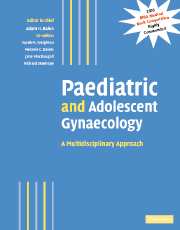Book contents
- Frontmatter
- Contents
- Contributors
- Preface
- Part I Normal development
- Part II Management of developmental abnormalities of the genital tract
- Part III Management of specific disorders
- 18 Disorders of growth and puberty
- 19 Turner's syndrome
- 20 Androgen insensitivity syndromes
- 21 Rokitansky syndrome and other Müllerian anomalies
- 22 The XY female
- 23 The gynaecology of the major genitourinary anomalies
- 24 Congenital adrenal hyperplasia
- 25 Long-term sequelae of genital surgery
- 26 Amenorrhoea
- 27 The polycystic ovary syndrome and adolescent women
- 28 Menstrual disorders in adolescent girls
- 29 Pelvic pain, ovarian cysts and endometriosis in adolescent girls
- 30 Premature ovarian failure and ovarian ageing
- 31 Gynaecological cancers in childhood
- 32 Late reproductive sequelae of treatment for childhood cancer
- 33 Preservation of fertility before cancer therapy
- 34 The management of infertility with surrogacy and egg donation
- 35 Dermatological conditions of the female genitalia
- 36 Vaginal discharge
- 37 Psychological gender development in individuals born with ambiguous genitalia
- 38 Eating disorders in adolescence
- 39 Nutritional amenorrhoea: long-term sequelae
- 40 How to set up a service: how to teach and train
- Index
- Plate section
- References
39 - Nutritional amenorrhoea: long-term sequelae
from Part III - Management of specific disorders
Published online by Cambridge University Press: 04 May 2010
- Frontmatter
- Contents
- Contributors
- Preface
- Part I Normal development
- Part II Management of developmental abnormalities of the genital tract
- Part III Management of specific disorders
- 18 Disorders of growth and puberty
- 19 Turner's syndrome
- 20 Androgen insensitivity syndromes
- 21 Rokitansky syndrome and other Müllerian anomalies
- 22 The XY female
- 23 The gynaecology of the major genitourinary anomalies
- 24 Congenital adrenal hyperplasia
- 25 Long-term sequelae of genital surgery
- 26 Amenorrhoea
- 27 The polycystic ovary syndrome and adolescent women
- 28 Menstrual disorders in adolescent girls
- 29 Pelvic pain, ovarian cysts and endometriosis in adolescent girls
- 30 Premature ovarian failure and ovarian ageing
- 31 Gynaecological cancers in childhood
- 32 Late reproductive sequelae of treatment for childhood cancer
- 33 Preservation of fertility before cancer therapy
- 34 The management of infertility with surrogacy and egg donation
- 35 Dermatological conditions of the female genitalia
- 36 Vaginal discharge
- 37 Psychological gender development in individuals born with ambiguous genitalia
- 38 Eating disorders in adolescence
- 39 Nutritional amenorrhoea: long-term sequelae
- 40 How to set up a service: how to teach and train
- Index
- Plate section
- References
Summary
Introduction
The amenorrhoea associated with energy deficit or nutritional imbalance has far-reaching long-term effects, including reduced bone density, stress fractures, osteopenia, osteoporosis, and infertility. This can be illustrated by referring to EG, a 54-year-old woman. She is a former professional ballet dancer who has performed on stages all over the world. Today, she relies on a walker in order to get from place to place. After a lifelong struggle with anorexia nervosa, she suffers from severe osteoporosis. She has suffered numerous fractures in the last 20 years and today her bone mineral density (BMD) is comparable to that of an 80-year-old woman. This is an extreme, though not uncommon, result of long-term nutritionally induced amenorrhoea.
Figure 39.1 shows the BMD scans for three women: a normal 25-year-old woman with regular periods; a 25-year-old woman who has had amenorrhoea for 5 years and has 30% lower total bone mass than most women her age; and a woman in her thirties with a 15 year history of amenorrhoea and osteoporotic bones.
There are a number of different environmental stressors thought to be associated with hypothalamic amenorrhoea (HA). Reproductive function may be affected by weight loss, exercise, nutritional deprivation or emotional stress. Recent research suggests that it may be an adaptive response to chronic low energy intake, and that metabolic factors may mediate reproductive adaptations in response to nutritional insults.
- Type
- Chapter
- Information
- Paediatric and Adolescent GynaecologyA Multidisciplinary Approach, pp. 522 - 532Publisher: Cambridge University PressPrint publication year: 2004

